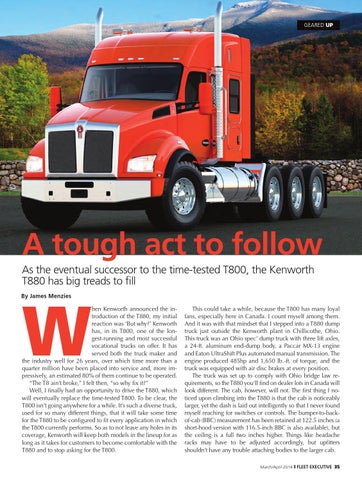GEARED UP
A tough act to follow As the eventual successor to the time-tested T800, the Kenworth T880 has big treads to fill
W
By James Menzies
hen Kenworth announced the introduction of the T880, my initial reaction was ‘But why?’ Kenworth has, in its T800, one of the longest-running and most successful vocational trucks on offer. It has served both the truck maker and the industry well for 26 years, over which time more than a quarter million have been placed into service and, more impressively, an estimated 80% of them continue to be operated. “The T8 ain’t broke,” I felt then, “so why fix it?” Well, I finally had an opportunity to drive the T880, which will eventually replace the time-tested T800. To be clear, the T800 isn’t going anywhere for a while. It’s such a diverse truck, used for so many different things, that it will take some time for the T880 to be configured to fit every application in which the T800 currently performs. So as to not leave any holes in its coverage, Kenworth will keep both models in the lineup for as long as it takes for customers to become comfortable with the T880 and to stop asking for the T800.
This could take a while, because the T800 has many loyal fans, especially here in Canada. I count myself among them. And it was with that mindset that I stepped into a T880 dump truck just outside the Kenworth plant in Chillicothe, Ohio. This truck was an Ohio spec’ dump truck with three lift axles, a 24-ft. aluminum end-dump body, a Paccar MX-13 engine and Eaton UltraShift Plus automated manual transmission. The engine produced 485hp and 1,650 lb.-ft. of torque, and the truck was equipped with air disc brakes at every position. The truck was set up to comply with Ohio bridge law requirements, so the T880 you’ll find on dealer lots in Canada will look different. The cab, however, will not. The first thing I noticed upon climbing into the T880 is that the cab is noticeably larger, yet the dash is laid out intelligently so that I never found myself reaching for switches or controls. The bumper-to-backof-cab (BBC) measurement has been retained at 122.5 inches (a short-hood version with 116.5-inch BBC is also available), but the ceiling is a full two inches higher. Things like headache racks may have to be adjusted accordingly, but upfitters shouldn’t have any trouble attaching bodies to the larger cab. March/April 2014 ❙ FLEET EXECUTIVE 35
p35-36_gearedup.indd 35
14-04-07 3:46 PM
